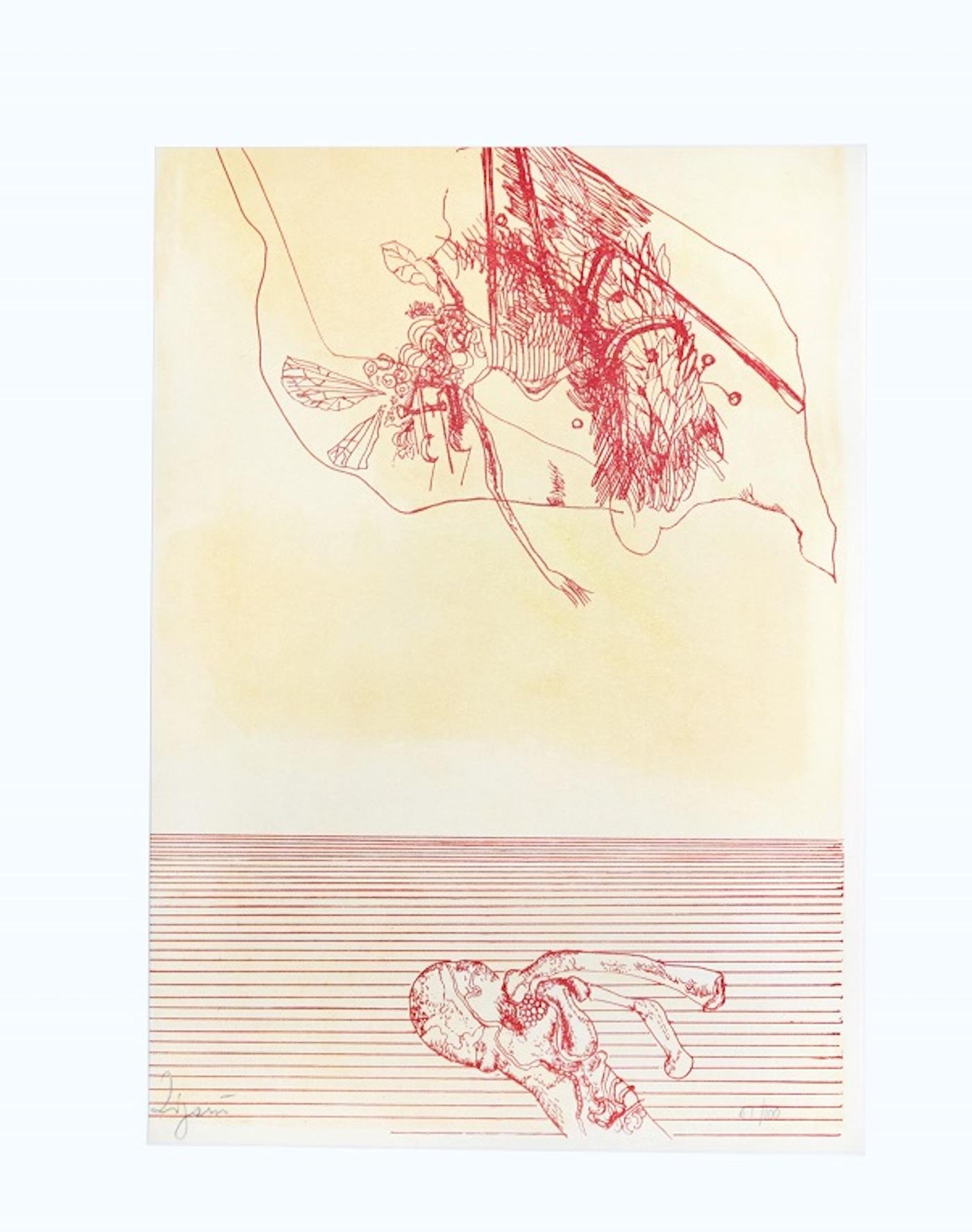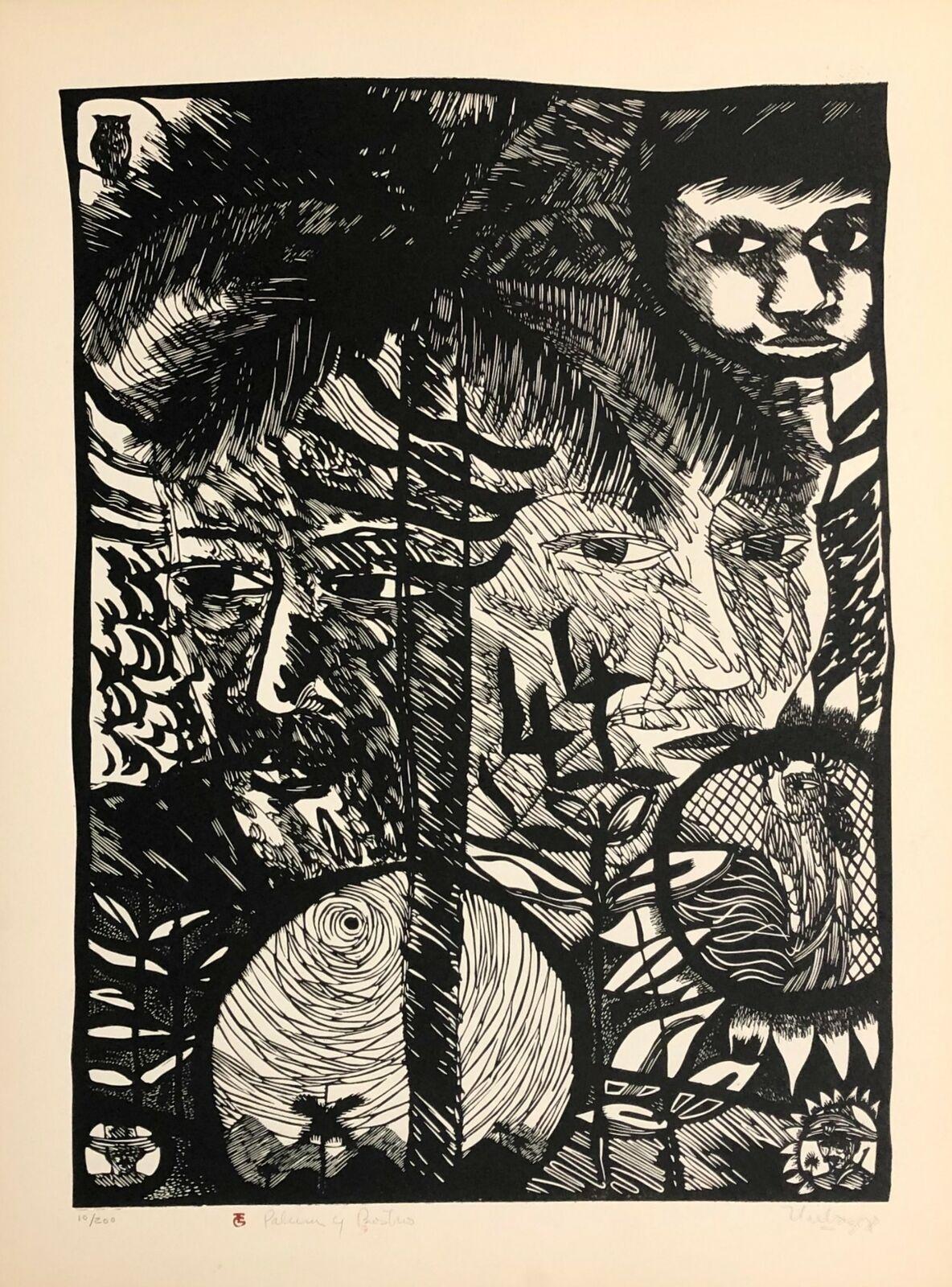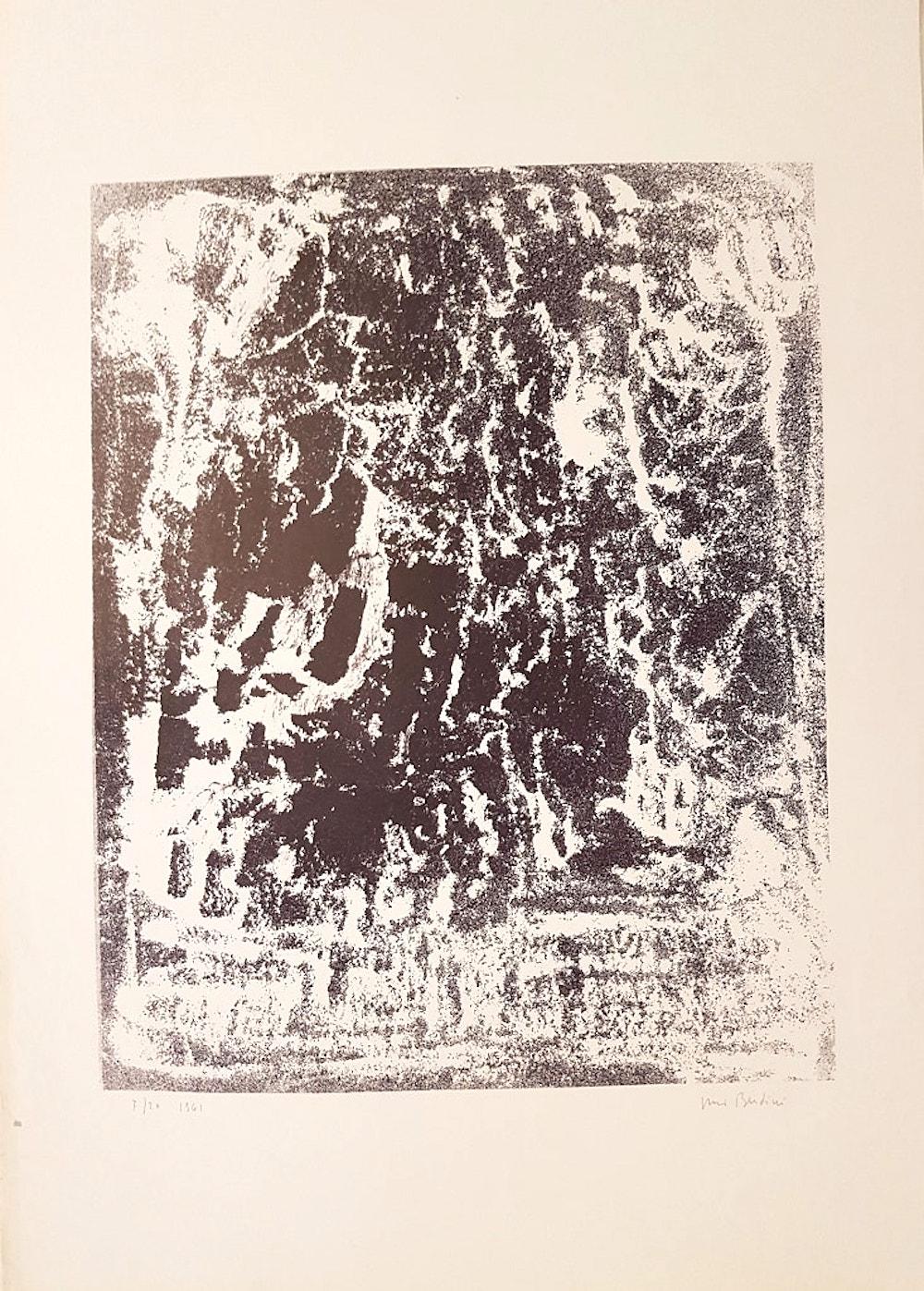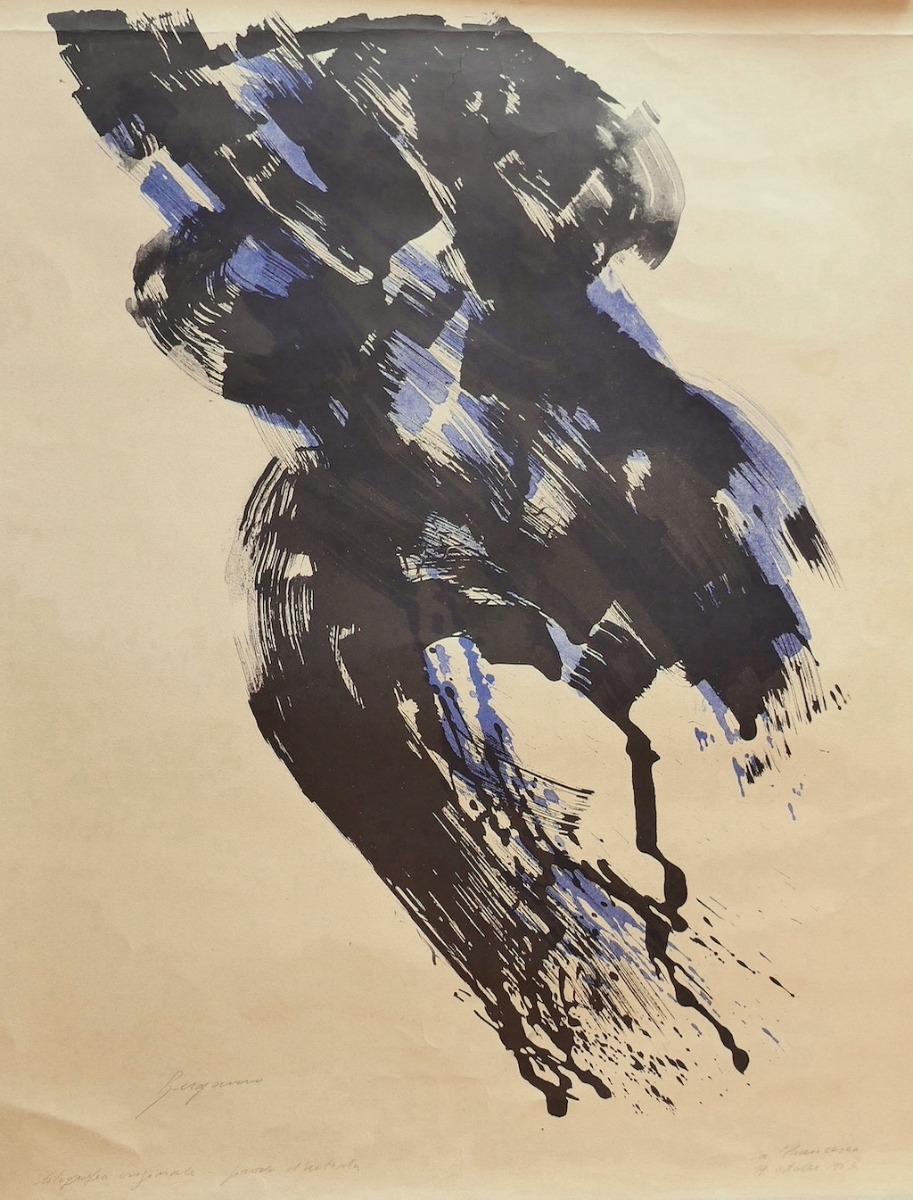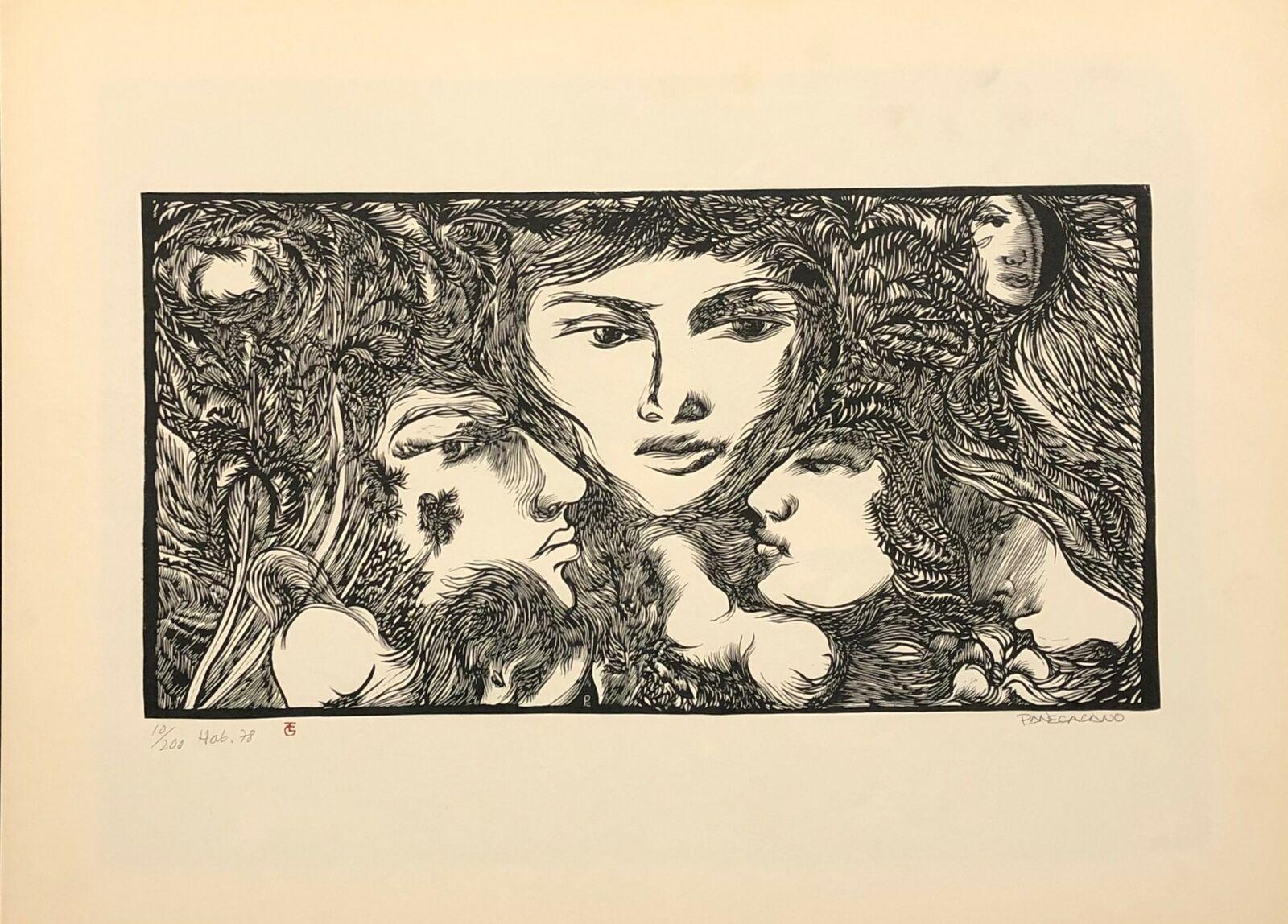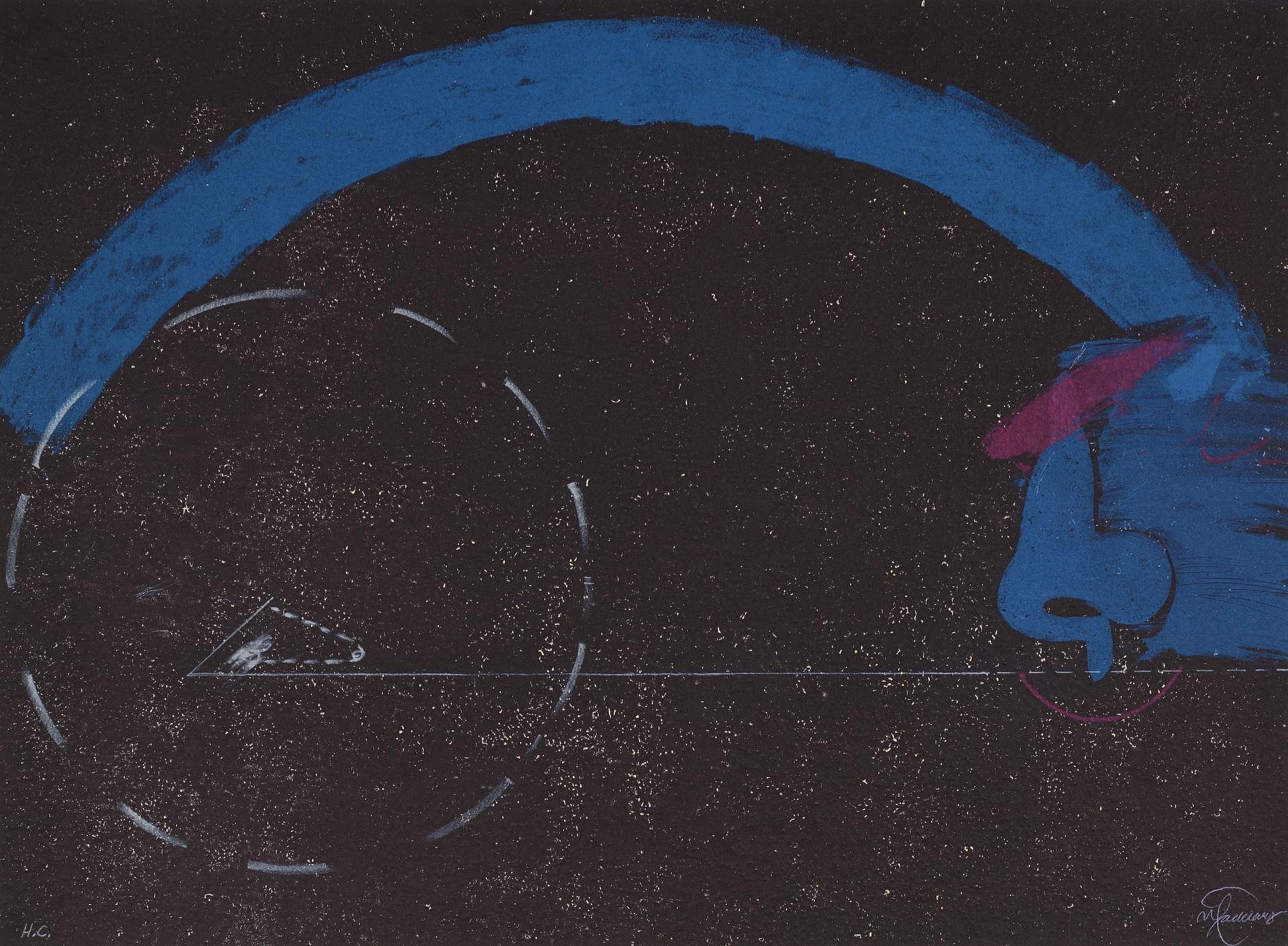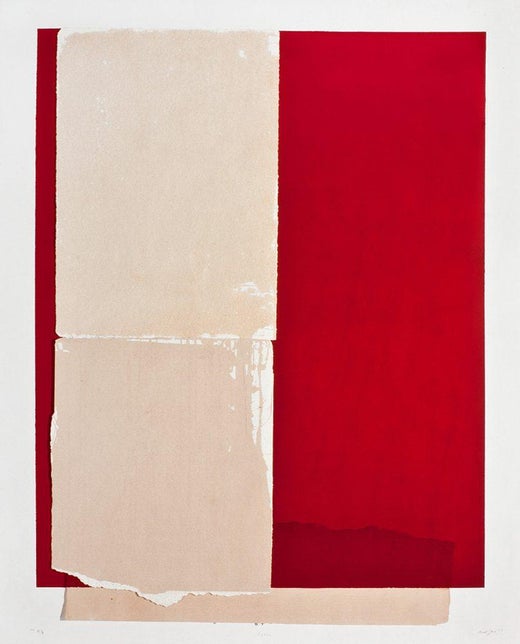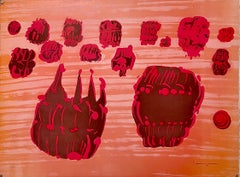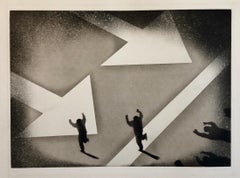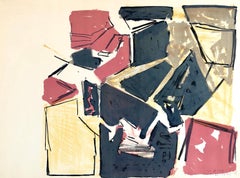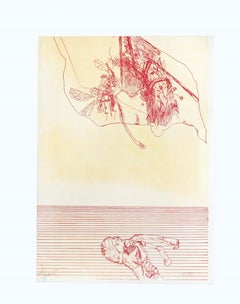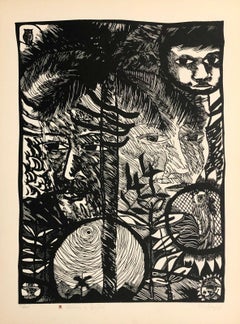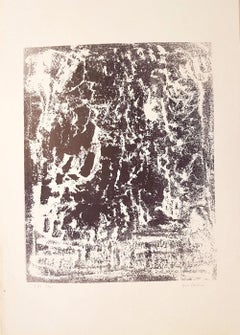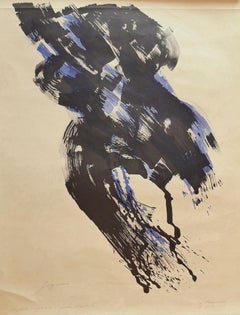Items Similar to El Herido, 1960's Spanish Avant Garde Political Screenprint Lithograph Signed
Want more images or videos?
Request additional images or videos from the seller
1 of 10
Rafael CanogarEl Herido, 1960's Spanish Avant Garde Political Screenprint Lithograph Signed1969
1969
$1,600
£1,232.76
€1,408.19
CA$2,290.68
A$2,498.45
CHF 1,313.66
MX$29,982.47
NOK 16,586.39
SEK 15,470.58
DKK 10,517.12
About the Item
The Wounded One (El Herido) from Violence (La Violencia) 1969 signed, dated and titled in pencil
Dimensions: sheet: 22 1/16 x 30 1/16" (56 x 76.4cm)
Rafael Canogar ( Toledo , 1935) is a Spanish painter, one of the leading representatives of abstract art in Spain.
Disciple of Daniel Vazquez Díaz (1948-1953), in his first works he found a way to reach the avant garde and, very soon, to study abstraction deeply.
He initially used a sculpture technique: with his hands he scratched or squeezed the paste that vibrated on flat colored backgrounds. It was a painting in which the initial gesture comes directly from the heart. At this point, Canogar embodied the best of painting material .
In 1957 he founded with other artists the EI Paso group. With artists like Luis Feito, Manolo Millares, Pablo Serrano, Manuel Rivera and Antonio Saura, he begins the Spanish avant-garde movement and continues to do so until 1960. It is influenced by Action painting. They defended, between 1957 and 1960 , an informal aesthetic and the opening of Franco Spain to the international scene. Informalism was eminently the expression of freedom, of the unique and unrepeatable, carried out with a direct and spontaneous calligraphy. Works eminently intuitive and passionate, made with the urgency that time, age and theories claimed. pieta, brothers in arms.
1974 Rafael Canogar participated along with Wolf Vostell , Edward Kienholz and other artists in Berlin in the activities of ADA - Aktionen der Avantgarde.
In 1975 he abandons this realism and during a period realizes eminently abstract works, an analysis of the painting, of the support, of the bidimensionality of the painting. But Canogar needs to invent a new iconography , recover the memory and - in a tribute to the historical avant-gardes - that he realizes through the mask, the head, the face, as a representation of the man who loses his individuality and becomes a plastic sign.
In 1982 receives the Golden Ball the National Prize of Plastic Arts . There are his works in several museums of modern art: Cuenca , Madrid, Barcelona, Turin, Rome, Caracas and Pittsburgh (Carnegie Institute), etc.
In 1984 he was included in the prestigious Various Artists with Antoni Tapies, Rufino Tamayo, Robert Motherwell, José Guerrero, Antoni Clave, Eduardo Chillida, Antonio Saura, Julio Le Parc, Rafael Canogar in the portfolio Declaracion Universal de Derechos Humanos
12 lithographs (3 with embossing, collagraph and/or varnish additions), 9 soft ground etchings (8 with aquatint, lift ground aquatint, and/or collagraph), 3 lift ground aquatints, 3 pochoirs, and 3 aquatints (1 with etching)
Member of the Board of Directors of the Círculo de Bellas Artes de Madrid
Member of the Advisory Board of the General Directorate of Fine Arts of the Ministry of Culture
Member of the Board of Directors of the National Heritage
Member of the Royal Academy of Fine Arts of San Fernando where he joined in 1998 .
- Creator:Rafael Canogar (1935, Spanish)
- Creation Year:1969
- Dimensions:Height: 22 in (55.88 cm)Width: 30 in (76.2 cm)
- Medium:
- Movement & Style:
- Period:
- Condition:minor wear commensurate with age, please see photos.
- Gallery Location:Surfside, FL
- Reference Number:1stDibs: LU38213542392
Rafael Canogar
Rafael Canogar (Toledo, 1935), painter and engraver, is considered as one of the leading figures of Spanish Abstract Art. Between 1948 and 1953 he was a disciple of Daniel Vázquez Díaz and focused on the study of the avant-garde and evolved rapidly to an informalist abstraction. In 1957, Canogar founded with Antonio Saura, Manuel Millares, Luis Feito, Manuel Rivera, Pablo Serrano, Juana Francés, Antonio Suárez and José Ayllón the El Paso group. Between 1957 and 1960 they all defended the informalism as an expression of freedom in an attempt to enter Spain in the international framework. In 1960 he participates in the "New Spanish Painting and Sculpture" show at MOMA New York. In 1963, he starts a new stage in his life in which he gradually gets close to figuration with a rising narrative content. In works of this period we find new materials such as newspaper clippings and photographs his subjects are close to the human and the nature of objects. As the critic Vicente Aguilera says about the works of this stage: "The themes do not express opinions or reflect facts, but facts are human tragedies, are encoded images where the human, object and amount, become symbolic hierarchy". In 1971 he is awarded with the Grand Prize of the Bienal de São Paulo. After 1975 we find in his work a return to an abstraction that quickly becomes a new iconography that represents man as a plastic element through masks and faces. Notable from this period are his still lifes, city scenes and the heads of Julio González. In 1982 he was awarded the National Prize of Plastic Arts.
About the Seller
4.9
Platinum Seller
Premium sellers with a 4.7+ rating and 24-hour response times
Established in 1995
1stDibs seller since 2014
1,838 sales on 1stDibs
Typical response time: 1 hour
- ShippingRetrieving quote...Shipping from: Surfside, FL
- Return Policy
More From This Seller
View AllPietro Consagra Italian Mod Abstract Expressionist Forma Brutalist Lithograph
By Pietro Consagra
Located in Surfside, FL
Pietro Consagra (Italian, 1920-2005).
Hand signed in pencil and numbered limited edition color lithograph on Magnani paper.
Embossed stamp with limited edition numbers in pencil to lower left, and having artist pencil signature to lower right.
(from a limited edition of 80 with 15 artist's proofs)
Published by Stamperia 2RC, Rome Italy and Marlborough Gallery, Rome, Italy.
Abstract Modernist work in colors, produced in the style of the Forma art movement of Postwar Italy, of which the artist was a prominent member.
Pietro Consagra (1920 – 2005) was an Italian Post war artist working in painting, printmaking and sculpture. In 1947 he was among the founding members of the Forma 1 group of artists, proponents of structured abstraction.
Consagra was born on 6 October 1920 in Mazara del Vallo, in the province of Trapani in south-western Sicily, to Luigi Consagra and Maria Lentini. From 1931 he enrolled in a trade school for sailors, studying first to become a mechanic, and later to become a captain. In 1938 he moved to Palermo, where he enrolled in the liceo artistico; despite an attack of tuberculosis, he graduated in 1941, and in the same year signed up at the Accademia di Belle Arti, where he studied sculpture under Archimede Campini. After the Invasion of Sicily and the Allied occupation of Palermo in 1943, Consagra found work as a caricaturist for the American Red Cross club of the city; he also joined the Italian Communist Party. Early in 1944, armed with a letter of introduction from an American officer, he travelled to Rome. There he came into contact with the Sicilian artist Concetto Maugeri, and through him with Renato Guttuso, who was also Sicilian and who introduced him to the intellectual life of the city and to other postwar artists such as Leoncillo Leonardi, Mario Mafai and Giulio Turcato. Consagra signed up at the Accademia di Belle Arti di Roma in September 1944 and studied sculpture there under Michele Guerrisi, but left before completing his diploma.
In 1947, with Carla Accardi, Ugo Attardi, Piero Dorazio, Mino Guerrini, Achille Perilli, Antonio Sanfilippo and Giulio Turcato, Consagra started the artist's group Forma 1, which advocated both Marxism and structured abstraction.
Steadily Consagra's work began to find an audience. Working primarily in metal, and later in marble and wood, his thin, roughly carved reliefs, began to be collected by Peggy Guggenheim and other important patrons of the arts. He showed at the Venice Biennale eleven times between 1950 and 1993, and in 1960 won the sculpture prize at the exhibition. During the 1960s he was associated with the Continuità group, an offshoot of Forma I, and in 1967 taught at the School of Arts in Minneapolis. Large commissions allowed him to begin working on a more monumental scale, and works of his were installed in the courtyard of the Foreign Ministry in Rome and in the European Parliament, Strasbourg. His work is found in the collections of The Tate Gallery, London, in Museo Cantonale d'Arte of Lugano and the Museum of Modern Art, Paris, and the National Gallery of Art in Washington, D.C..
Consagra returned to Sicily where he sculpted a number of significant works during the 1980s. With Senator Ludovico Corrao, he helped created an open-air museum in the new town of Gibellina, after the older town had been destroyed in the earthquake of 1968. Consagra designed the gates to the town's entrance, the building named "Meeting" and the gates to the cemetery, where he was later buried.
In 1952 Consagra published La necessità della scultura ("the need for sculpture"), a response to the essay La scultura lingua morta ("sculpture, a dead language"), published in 1945 by Arturo Martini. Other works include L'agguato c'è ("the snare exists", 1960), and La città frontale ("the frontal city", 1969). His autobiography, Vita Mia, was published by Feltrinelli in 1980. In 1989 a substantial retrospective exhibition of work by Consagra was shown at the Galleria Nazionale d'Arte Moderna in Rome; in 1993 a permanent exhibition of his work was installed there. In 1991 his work was shown in the Hermitage Museum in St. Petersburg. In 2002 the Galerie der Stadt Stuttgart opened a permanent exhibition of his work. He was one of ten artists invited by Giovanni Carandente, along with David Smith, Alexander Calder, Arnaldo Pomodoro, Lynn Chadwick, and Beverly Pepper, to fabricate works in Italsider factories in Italy for an outdoor exhibition, "Sculture nella città", held in Spoleto during the summer of 1962. He was included in the The 1962 International Prize for Sculpture the jury included Argan, Romero Brest and James Johnson Sweeney the former director of the Solomon R. Guggenheim Museum in New York. The participants included Louise Nevelson and John Chamberlain for the United States; Lygia Clark for Brazil; Pietro Consagra, Lucio Fontana, Nino Franchina, and Gió Pomodoro for Italy; Pablo Serrano for Spain; and Eduardo Paolozzi, William Turnbull, and Kenneth Armitage for England. Gyula Kosice, Noemí Gerstein, Julio Gero, Naum Knop...
Category
1960s Abstract Expressionist Abstract Prints
Materials
Lithograph
1970 Silencio, Direccion Unica, One Way Spanish Political Etching Pop Art Print
By Juan Genoves
Located in Surfside, FL
Juan Genovés Candel (Spanish, 1930-)
Painter, illustrator, and graphic printmaker engraver. He painted 'El abrazo' ('the embrace'), which became an emblematic poster during the Spanish political transition. He was born in Valencia in 1930. The son of Juan Genovés Cubells, an artisan whose family was close to the labor movement. His mother Maria Candel Muñoz came from a family of practicing Catholics. In 1946 Genovés studied at the Escuela de Bellas Artes de San Carlos in Valencia and then settled in Madrid. He set up the 'Los Siete' group together with other artists in 1949, and the following year he travelled to Madrid, where he was influenced by the works by Fra Angélico and Hieronymus Bosch in the Prado Museum. In 1957 he had his first solo exhibitions in the gallery Alfil, Madrid and in the Museo d'Arte Moderna, Havana. He is considered the most important representative of modern Spanish painting. His images, executed in a politically engaged, critical realism...
Category
1970s Pop Art Figurative Prints
Materials
Lithograph
Israeli Surrealist Judaica Abstract Lithograph Naftali Bezem
By Naftali Bezem
Located in Surfside, FL
Naftali Bezem (Hebrew: נפתלי בזם; born November 27, 1924) is an Israeli painter, muralist, and sculptor.
Bezem was born in Essen, Germany, in 1924. His early adolescence was spent...
Category
20th Century Modern Prints and Multiples
Materials
Lithograph
Israeli Josef Zaritsky Abstract Modernist Lithograph Print "Composition"
Located in Surfside, FL
Abstract Composition, 1959 Lithograph
This was from a portfolio which included works by Yosl Bergner, Menashe Kadishman, Yosef Zaritsky, Aharon Kahana, Moshe Tamir and Michael Gross.
Joseph (Yossef) Zaritsky (Hebrew: יוסף זריצקי; September 1, 1891 – November 30, 1985) was one of Israel's greatest artists and one of the early promoters of modern art in the Land of Israel both during the period of the Yishuv (Palestine, the body of Jewish residents in the Land of Israel before the establishment of the State of Israel) and after the establishment of the State. In 1948 Zaritsky was one of the founders of the "Ofakim Hadashim" group. In his works he created a uniquely Israeli style of abstract art, which he sought to promote by means of the group. For this work he was awarded the Israel Prize for painting in 1959.
Joseph Zaritsky...
Category
1950s Modern Abstract Prints
Materials
Lithograph
Abstract Latin American Art Spanish Catalan Lithograph Josep Guinovart New York
By Josep Guinovart Bertrán
Located in Surfside, FL
Guinovart, Josep (Spanish/Catalan, 1927-2007), Untitled Abstract, 1984, lithograph on paper, hand signed, dated and marked E.A. (artist's proof) in pencil at bottom, full sheet 26.75 x 22 inches, unframed.
Josep Guinovart (1927 –2007) was a Spanish Catalan painter most famous for his informalist or abstract expressionist work.
In 1941, he began to work as a decorator. Three years later, he started his studies at the Escuela de Artes y Oficios de la Llotja (Art School of La Llotja) where he stayed until 1946.
He first exhibited his work in 1948 in Galerías Syla in Barcelona. In 1951, he produced his first engravings entitled 'Homage to Federico García Lorca'. Two years later, he was awarded a grant from the French Institute to study in Paris for nine months. Here he discovered the cubist works of Henri Matisse and Pablo Picasso and travelled to Belgium, Holland and Germany.
On his return to Barcelona and after a period working as an illustrator and set designer, around 1957 he began moving towards abstract art. His work is highly unconventional and usually on a large scale, using a wide range of materials, three-dimensional objects and organic substances such as eggshell, earth and straw.
In 1962, he illustrated a book of poetry entitled Posies by Joan Salvat-Papasseit for the Ariel Editorial. He won many accolades for his work throughout the 1970s and 80s, including Spain's National Award for Plastic Arts in 1982. In 1994, a museum foundation dedicated to his art was inaugurated in Agramunt, his mother's birthplace to which he always felt a special attachment.
In 2006 he designed the winery Mas Blanch i Jové in La Pobla de Cérvoles (Lleida) and created The Artists' Vineyard, a project intended to mix sculptures and other art works from different artists in the middle of a vineyard. The Artists' Vineyard was inaugurated after his death in 2010 with the unveiling of his sculpture The Countryside Organ: a music instrument, 6 meters height, for the wind to sing the vines. This winery also displays the 10.5 meters work In Vino Veritas...
Category
1980s Abstract Abstract Prints
Materials
Lithograph
Apeles Fenosa Spanish Sculptor Mourlot Lithograph Abstract Expressionist Figures
By Apelles Fenosa
Located in Surfside, FL
This is from a hand signed, limited edition (edition of 125) folio or full page lithographs some having a poem verso. The individual sheets are not signed or numbered. This listing ...
Category
1970s Expressionist Figurative Prints
Materials
Lithograph
You May Also Like
Untitled - Original Lithograph by Giuseppe Zigaina - 1970s
By Giuseppe Zigaina
Located in Roma, IT
Untitled is a contemporary colored lithograph realized by the Italian artist Giuseppe Zigaina in the 1970s.
This print is hand-signed in pencil on the lower left. Numbered on the lo...
Category
1970s Contemporary Abstract Prints
Materials
Lithograph
Carlos Uribazo Cuban Artist Original Hand Signed silkscreen 1978
Located in Miami, FL
Carlos Uribazo (Cuba, 1951)
'Untitled (from Porfolio Grabados Cubanos)', 1978
silkscreen on paper Canson 320 g.
23.6 x 17.6 in. (59.8 x 44.6 cm.)
Edition of 200
ID: URI-302
Hand-sign...
Category
1970s Contemporary Prints and Multiples
Materials
Paper, Engraving, Screen
Untitled - Original Lithograph by Vasco Bendini - 1961
By Vasco Bendini
Located in Roma, IT
Image dimensions: 49 x 38 cm.
Interesting b/w lithograph representing a abstract composition. Dated, numbered and hand-signed with pencil on lower margin by the Italian artist, Vasc...
Category
1960s Abstract Prints
Materials
Lithograph
Composition - Original Lithograph by Danilo Bergamo - 1963
By Danilo Bergamo
Located in Roma, IT
Composition is an original lithograph on paper realized by Danilo Bergamo in 1963.
Artist's proof.
Good conditions except for foldi...
Category
1960s Contemporary Abstract Prints
Materials
Lithograph
Rafael Paneca Cuban Artist Original Hand Signed silkscreen 1978 n4
Located in Miami, FL
Rafael Paneca (Cuba, 1949)
'Untitled (from Porfolio Grabados Cubanos)', 1978
silkscreen on paper Canson 320 g.
17.6 x 23.6 in. (44.6 x 59.8 cm.)
Edition of 200
ID: PAN-304
Hand-signe...
Category
1970s Contemporary Prints and Multiples
Materials
Paper, Engraving, Screen
Spanish 1974 signed limited edition original art print lithograph n5
Located in Miami, FL
Joan-Pere Viladecans (Spain, 1948)
'Entrebanc 13', 1974
lithograph on paper
22.1 x 30 in. (56 x 76 cm.)
Unframed
ID: VIL1324-005-000
Hand-signed by author
Category
1970s Contemporary Prints and Multiples
Materials
Paper, Lithograph, Engraving
More Ways To Browse
Toledo Spain
Toledo Spanish
Antonio Saura
Manolo Millares
Antonio Rivera
Nazi Uniform
Paul Collomb
Richard Reed
Robert Motherwell Elegy
Robert Natkin Lithograph
Shinoda Toko
Sister Corita Prints
Vintage Field And Stream Cover Art
Warhol Rose
11 Pop Artists
Agam Agamograph
Alexander Calder Braniff
Anuszkiewicz Signed
